How to change the heater in a water heater: step-by-step instruction of repair work
In the list of irreplaceable devices, the purchase of which they think primarily when moving to a new house, apartment or cottage, is a water heater. It makes residents independent of hot water - you can just turn on the appliance and take a shower.
But such household appliances need regular maintenance, and some elements do need replacement. Therefore, the owner will need knowledge on how to do the prophylaxis in order to avoid breakdowns, and how to change the heater in the water heater if it still fails.
The content of the article:
The design of the water heater
The boiler is basically no different from the most ordinary electric kettle, which can maintain a certain temperature of the water. Only the first acts as a cover safety valveproviding the supply of the required amount of liquid for its subsequent heating.
Today the market offers a large selection of boilers. All modern models have different designs, specifications, appearance and, of course, different prices.
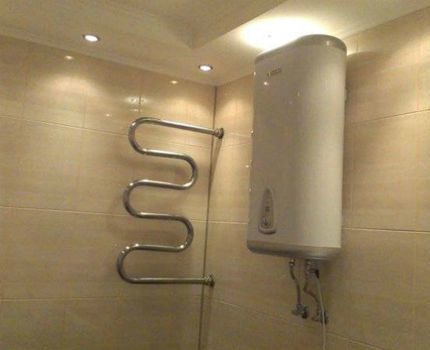
Therefore, choose the model that is optimal in terms of parameters, quality and cost storage water heater can a buyer with any income level.
Regardless of the brand, all boilers consist of the following components:
- body - it must be insulated, which will reduce heat loss to a minimum;
- a heating element - There are two varieties of it: the first is in direct contact with water, and the second heats the liquid through a special ceramic shell;
- inner tank - its volume varies from 15 to 200 liters, and the tank itself is made of stainless steel, which allows it to be resistant to corrosion;
- thermostat - a sensor that monitors the temperature of the water, maintaining it at a level set by the user;
- magnesium anodewhose main task is to protect the device from electrochemical corrosion, but it in no way affects the formation of scale;
- gasket the attachment point of the heating element.
The magnesium anode needs regular replacement - this process needs to be addressed at least 1-2 times a year. Such maintenance will increase the life of the boiler and increase its efficiency.

The principle of operation of the device
The heater is two containers isolated from each other. The first barrel, as a rule, is made of stainless steel coated with a corrosion-resistant coating, or stainless steel.
Innovative materials are used to organize insulation. Most often it can be polyurethane foam, basalt cotton wool or their analogues. This solution allows you to keep the water hot for up to two to three days. If the temperature of the liquid falls below a value set by the user, an electric current is supplied to the heating element.
At the same time, to prevent mixing of hot and cold liquids, the latter is taken at the top of the device. In this case, the laws of physics work. More specifically, cold water simply displaces hot water.
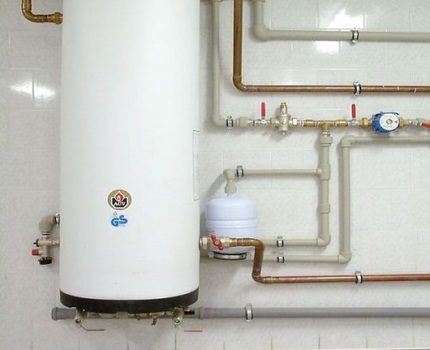
It is recommended to adjust the thermostat to t = 60. In this case, scale formation can be prevented, which will have a beneficial effect on the inner barrel and heating elements. But in any case, every month you need to turn on the device to the maximum. This solution will disinfect the container, killing all the harmful bacteria.
Reasons to replace the heater
It is necessary to replace the heater in case of failure of the old element. But how to determine that the heater has really burned out? To do this, plug the boiler into a power outlet and wait until it responds.
If the device immediately turns off, then this is a clear sign of a problem. Well, in the case when the equipment continues to work, there are no malfunctions and the need for repair, respectively, also.
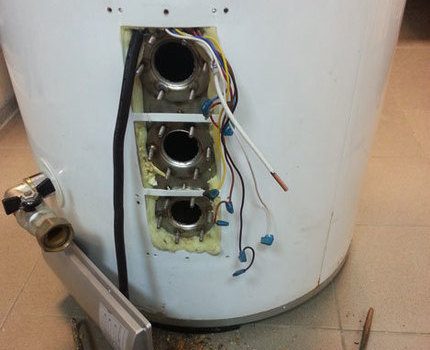
To finally verify the malfunction of the part, it is necessary, so to speak, to “ring” it. Simply put, evaluate the conductive characteristics.
To do this, carry out the following procedure:
- unplug equipment;
- unscrew the protective cover;
- find the contacts of the heating element;
- check component resistance.
For testing, you can use an ohmmeter or multimeter. If the measuring device shows "infinity", then the heater has become unusable (burned out) and needs to be replaced. Well, when the device shows zero or some exact number, then there are no problems.
Should I replace by myself?
Water heating equipment has a fairly simple design and works on an elementary basis. Therefore, each home master will be able to cope with the replacement of the heating element independently, without calling a specialist.
The main disadvantage of attracting a professional is the high cost of repair.Often this figure can reach $ 60 and this is only for work, without taking into account the cost of parts. Therefore, spending a little of your own time can save a significant amount.
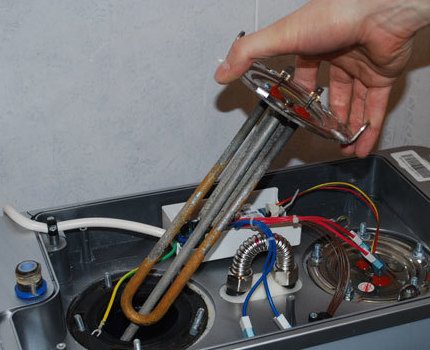
Checking the health of the heater
The above test method with an ohmmeter is not the only method for determining failure. There are two more options that allow you to identify all kinds of problems and fix them in a timely manner, preventing the complete failure of the device. Let's consider them in more detail.
Visual inspection of the item
In this case, it is necessary to disconnect the equipment from the electrical network and drain the water from it. Then disassemble it and clean the heating element from scale, if it is present on its surface. It is important to inspect the component for coating integrity.
If even small cracks, chips or damage are detected, the part can be safely sent to the trash bin. Indeed, in this case, it will not be possible to repair it. The only thing that remains in this situation is to replace the heater with a new one.
The cause of damage to the coating of an element most often lies in the low quality of the materials used for its production. As a result, after one or two years of operation, such a heater is literally torn to shreds and cannot be restored.
Test with a tester
One of the methods for detecting a failure of the heater was given above. But if the ohmmeter did not give results, and nothing was found during the visual inspection, then the last check is to find a breakdown.
To do this, disconnect one of the terminals of the measuring device and lead it on the surface of the water heating element. If the ohmmeter showed the exact value of the resistance, then there is a problem and the heater must be sent to the scrap.
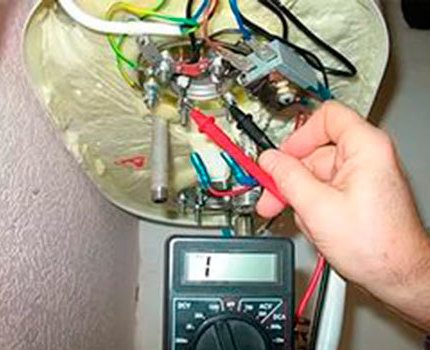
If everything is in order with the heating element, then proceed with checking the thermostat. To do this, connect the terminals of the measuring device to the contacts of the temperature sensor, which are used to supply electric current.
If the measuring device showed the exact value or issued a call, then the component is fully operational. Otherwise, the thermostat is broken and must be replaced. And for this, you don’t even have to drain the water from the boiler.
To restore operability, disconnect the device from electricity, remove the panel, disconnect all wires from the thermostat and connect a new part. Remember that if you do not solve such a problem, then there is a risk of electric shock if you touch the tank.
What will be needed for repair?
If the presence of a malfunction is nevertheless confirmed, then it is time to start replacing the heater. But before you get started, you need to get all the necessary tools. The list is small, but without it it is unlikely that something will be done.
For repair you will need:
- spanners;
- pliers;
- rags or napkins - they should absorb water well;
- screwdrivers - it is advisable to stock up on the cross and straight;
- phasometer - the instrument is a screwdriver with a special indicator integrated in its handle;
- new heating element.
Armed with everything you need, you can proceed directly to the repair. For everything to succeed, you need to follow a certain procedure, which will be discussed later.
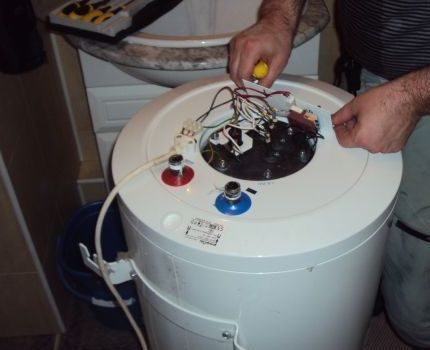
Replacing a water heater
First of all, you must turn off the water supply.Typically, a floor tap is located near the boiler. If there is none, you can block the water in the entire apartment (from the riser).
Each master can choose any of two ways. The main thing is to stop filling the tank with water. Note that the DHW supply tap must also be closed.
Next, you must perform the following steps:
- drain the boiler;
- disconnect the device from the power supply;
- remove the protective panel, for which a screwdriver is useful;
- using a phase meter, make sure that there is no voltage at the water terminals;
- remove the heater from the mounts;
- disconnect the wires - before doing this, it’s better to photograph the original circuit, which will eliminate many problems;
- unscrew the nuts securing the heating element.
Together with the heating element, the anode protecting the boiler from rust should also be replaced. Then you can install new parts. In this case, make sure that their contacts are dry. Indeed, otherwise there is a risk of a short circuit.
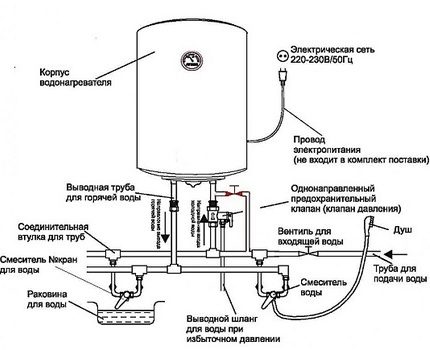
After all the hoses have been connected, the equipment is tested for cold water. Please note that the device must not be plugged in yet. After all, you first need to check if there is a leak. If there are no problems, then after all the air exits through the faucet with hot water, you can turn on the device in the network.
To make the operation of the boiler as safe as possible, there are several things to check. First of all, you need to make sure that there is grounding, which must be provided during boiler installation.
Installation will be a good addition residual current circuit breakersas well as laying a separate power line with its own circuit breaker to protect wiring.
A useful part is the safety valve. He will not allow the pressure in the inner tank to be too high. Also, the element is useful for draining the liquid. To preserve boiler components in the event of a water supply interruption, it is recommended to install a non-return valve on the cold line.
How to increase the life of the heater?
In order not to think for a long time about the need to replace the water heating element, you should order it only from trusted suppliers who supply equipment for heating water. In this case, before buying, you must carefully study the instructions.

To improve the quality of the water that enters the tank, you need to install cleaning filters. An even wiser decision is to organize the cleaning of the liquid from all kinds of impurities. Multistage filtration devices will help to cope with this.
Do not forget to conduct a routine inspection of the water heater at least once a year. Regular maintenance will allow you to identify problems in a timely manner and solve them without spending a large amount on it.
Conclusions and useful video on the topic
Video # 1. Descaling the heater in a water heater:
Video # 2. Replacing the heating element of the boiler:
A water heater is an indispensable device that ensures the operation of an autonomous water supply system. Such equipment will allow you to take a shower and bath whenever you want. But in order to enjoy the benefits of civilization, it is necessary to constantly monitor the state of the boiler, annually clean it and change worn parts.
Tell us about how you changed the tubular electric heater in the boiler with your own hands. Share technological subtleties that may be useful to interested visitors to the site.Please leave comments in the block below, post pictures and ask questions about the topic of the article.

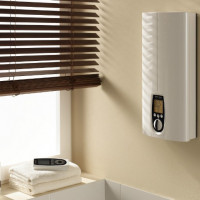 DIY instantaneous water heater installation: step-by-step instruction
DIY instantaneous water heater installation: step-by-step instruction 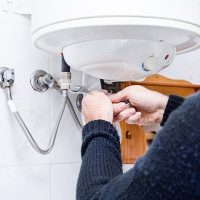 How to drain water from a water heater: the pros and cons of different methods + an example of work
How to drain water from a water heater: the pros and cons of different methods + an example of work 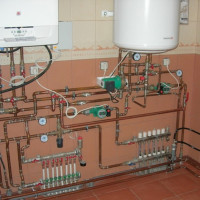 Connecting an electric boiler to a gas boiler: the best schemes and work procedures
Connecting an electric boiler to a gas boiler: the best schemes and work procedures 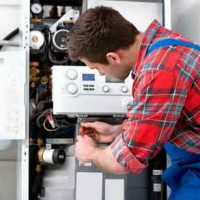 How to replace the gas column membrane: reasons + repair instructions
How to replace the gas column membrane: reasons + repair instructions 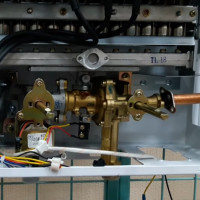 Repair of a water column of a geyser: assembly of a node, major breakdowns and detailed instructions for repair
Repair of a water column of a geyser: assembly of a node, major breakdowns and detailed instructions for repair 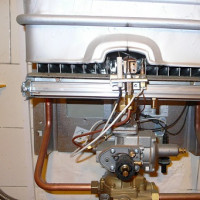 Why the geyser buzzes, clicks, whistles and pops: causes of problems and solutions
Why the geyser buzzes, clicks, whistles and pops: causes of problems and solutions  How much does it cost to connect gas to a private house: the price of organizing gas supply
How much does it cost to connect gas to a private house: the price of organizing gas supply  The best washing machines with dryer: model rating and customer tips
The best washing machines with dryer: model rating and customer tips  What is the color temperature of light and the nuances of choosing the temperature of the lamps to suit your needs
What is the color temperature of light and the nuances of choosing the temperature of the lamps to suit your needs  Replacement of a geyser in an apartment: replacement paperwork + basic norms and requirements
Replacement of a geyser in an apartment: replacement paperwork + basic norms and requirements
When the old water heater was standing, problems constantly occurred with the heater. Often had to make a replacement. He began to search for information, and found a lot of interesting things. It turns out that you can not turn on the boiler without water. A couple of times this happened by chance. Plus, it was necessary to regularly check the water heating element. Now I have installed new equipment. To avoid problems with the heater, I decided to put a filter in front of the unit, because the heater was quickly covered with scale. So far no problems have arisen.
Of course you can not turn on the boiler without water, this is one of the basic rules. TEN very quickly burns out if so done. Although, in theory, it should not turn on, if the device with a thermal fuse, fool protection should work.
And I, too, was tormented by an old boiler with burned Ten. And replace them with a whole problem. Drain the water, dismantle half of the heater. In short, he was old, and I changed it to a new one. I took a new one with dry heating elements and I am very happy about it. Changing them is much easier. No need to drain the water. Yes, and they fail less often. They do not form scale, since there is no direct contact with water. Conveniently.
I also think about taking a boiler with a dry heater. Can anyone have experience using such boilers? What jambs can they have? Since in the ordinary boiler it is the tens that often fail and the anode needs to be changed periodically, well, it can still fly (if there is, of course, in the kit). So there is nothing more to break. And what flies more often in boilers with dry heating elements?